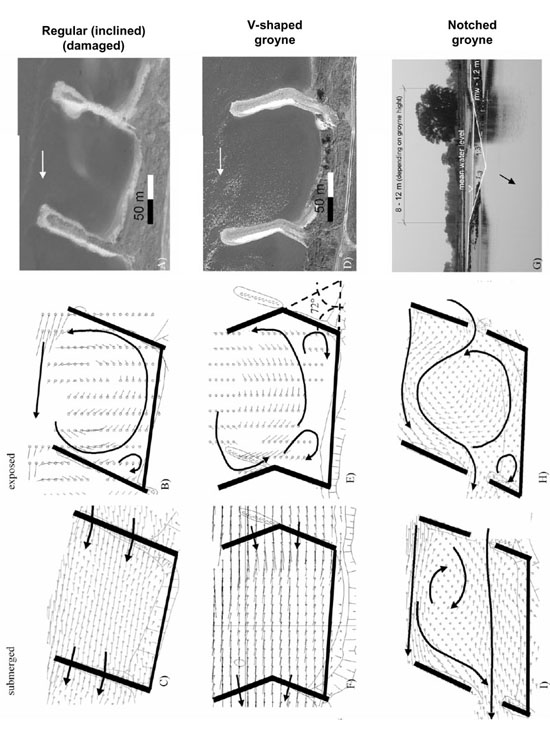Remove or modify in-channel hydraulic structures
Contents
- 1 Remove or modify in-channel hydraulic structures
- 1.1 General description
- 1.2 Applicability
- 1.3 Expected effect of measure on (including literature citations):
- 1.4 Temporal and spatial response
- 1.5 Pressures that can be addressed by this measure
- 1.6 Cost-efficiency
- 1.7 Case studies where this measure has been applied
- 1.8 Useful references
- 1.9 Other relevant information
Remove or modify in-channel hydraulic structures
Remove or modify in-channel hydraulic structures06. In-channel structure and substrate improvement
General description
In-channel hydraulic structures like groynes and deflectors are used in river engineering to stabilize banks and to concentrate the flow in the middle of the channel to achieve a sufficient fairway depth at medium and low discharges, resulting in a fixed river planform, a navigation channel that is relatively deep over a large part of its cross-section, and sedimentation between the groynes (groyne fields). In waterways, groyne fields are often the only shallow, low-velocity areas with some flow- and substrate diversity (although often impacted by ship-induced waves).
By removing or modifying in-channel hydraulic structures like groynes, flow- and substrate diversity can be further increased and aquatic and semi-terrestrial habitats can be improved. Different types of groynes have been used: V-shaped and notched groynes (see Figure below) and L-shaped groynes.
Regular inclined groynes deflect the water away from the river bank when submerged. V-shaped groynes also deflect the water away from the river bank, but in addition direct the current to the middle of the downstream groyne field, resuspending fine material which has deposited during low-flow periods. In contrast to one large eddy in regular groyne fields, flow-diversity is higher during low- and mean-flow periods. Notched groynes result in a second flow profile near the river bank at high flows and a more diverse flow-pattern during low- and mean-flows (Kleinwächter et al. 2005). Another groyne type are L-shaped groynes, where an additional parallel structure is build at the head of the inclined groyne parallel to the flow to protect the groyne field from ship-induced waves.
Applicability
The fine sediment deposition in the groyne fields often are contaminated with pollutants or nutrients (Schwartz and Kozerski 2003). Removing or modifying groynes may remobilize these sediments and affect downstream river reaches. Therefore, from an ecological point of view, it is desirable that the organic mud should be removed from the river and deposited in a controlled landfill prior to removing or modifying groynes (see fact-sheet “Remove Sediments”).
Expected effect of measure on (including literature citations):
HYMO (general and specified per HYMO element)
- Increase in flow- and sediment diversity (higher flow velocities, coarser sediment), especially in groyne fields of notched groynes (Kleinwächter et al. 2005, Rödiger et al. 2010).
- Increase of low-velocity zones protected from ship-induced waves and increase in substrate diversity due to sedimentation of fines in groyne fields of L-shaped groynes (Gies and Lorenz 2009).
Physico-chemical parameters
- No information available
Biota (general and specified per Biological quality elements)
| BQE | Macroinvertebrates | Fish | Macrophytes | Phytoplankton |
|---|---|---|---|---|
| Effect | medium | medium | medium | no effect |
Macroinvertebrates:
- Increase in invertebrate abundance and diversity in groyne fields of L-shaped groynes (Gies and Lorenz 2009).
- Increase of abundance of invertebrates inhabiting shallow low-velocity areas (Kleinwächter et al. 2005) and probably also invertebrates inhabiting stable sandy substrate.
- Habitat quality for macroinvertebrates is especially enhanced by the notched groynes (Rödiger et al. 2010).
Fish:
- Increase in fish diversity in modified groyne fields (Fladung et al. 2003).
- Increase of high-flow velocity areas, leading to coarser grain sizes, potentially favour juveniles of rheophilic fish species (Kleinwächter et al. 2005).
Macrophytes:
- Possibly influences macrophyte composition due to changes in flow-diversity.
Phytoplankton:
- Probably no effect on phytoplankton.
Temporal and spatial response
Pressures that can be addressed by this measure
- Channelisation / cross section alteration
- Alteration of instream habitat
- Embankments, levees or dikes
- Artificial barriers upstream from the site
- Artificial barriers downstream from the site
Cost-efficiency
High cost-efficiency if existing groynes are modified especially within the common maintenance work, medium cost-efficiency if new groynes are built (due to low to medium cost and medium ecological effect).
Case studies where this measure has been applied
- Charlottenburg wave-protected shallow
- Chícamo Life project. Conservation of Aphanius iberus´ genetics stocks ( Murcia ).
- Regelsbrunner Aue
- Vén Duna - side arm reopening
- Opijnen - Side Channel
- Vreugderijkerwaard - Side channel
- Klebach - Side channel
- Thur
- Narew river restoration project
- Bouxweerd - Artificial pool
- Töss
- Stream -mending the Avon
- Sella
- Drava - Kleblach
Useful references
Adam, P, N. Debiais and J. R. Malavois. 2007. Manuel de restauration hydromorphologique des cours d´eau. Fiche 3. Épis. Direction de l´eau, des milieux aquatiques et de l´agriculture (DEMAA) Service Eaux de Surface. L´Agence de l´eau Seine-Normandie.
Stream corridor Restoration: Principles, Processes and Practices. 2001. Federal Interagency Stream Restoration Working Group. USDA- Natural Resources Conservation Service
